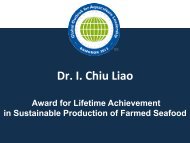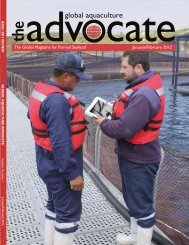May/June 2010 - Global Aquaculture Alliance
May/June 2010 - Global Aquaculture Alliance
May/June 2010 - Global Aquaculture Alliance
You also want an ePaper? Increase the reach of your titles
YUMPU automatically turns print PDFs into web optimized ePapers that Google loves.
water Temperature (° C)<br />
30<br />
20<br />
10<br />
0<br />
Guayaquil, Ecuador<br />
Auburn, Alabama, USA<br />
J F M A M J J A S O N D<br />
Match<br />
in a process caused by a 10° C temperature<br />
is called the Q . To illustrate, if fish<br />
10<br />
grow 1.8 times faster at 30° than at 20° C,<br />
Q is 1.8.<br />
10<br />
Water temperatures at most locations<br />
vary between seasons, even in the tropics.<br />
This phenomenon is illustrated in Figure<br />
1 with data from Auburn, Alabama,<br />
USA, at 32° 36’ N latitude and for Guayaquil,<br />
Ecuador, at 2° 9’ S latitude.<br />
A small difference in temperature can<br />
appreciably affect shrimp growth rate.<br />
Suppose shrimp grow at 1.20 g/week<br />
during a period when water temperature<br />
averages 27° C. Assuming Q = 2 for<br />
10<br />
shrimp growth, an increase in temperature<br />
to 29° C should increase growth rate<br />
to 1.44 g/week. Of course, plants and<br />
animals have a range of temperature tolerance,<br />
and Van Hoff’s law does not<br />
apply outside the temperature range for<br />
optimum growth. In the example above,<br />
if 29° C is above the optimum temperature<br />
for shrimp growth, there would be a<br />
Figure 1. Water temperatures<br />
at a temperate<br />
and tropical location.<br />
decrease in growth at the higher temperature.<br />
A study in Poland revealed that a<br />
difference in 1° C from the mean seasonal<br />
temperature can alter common carp production<br />
in intensive systems by 1,000 kg/<br />
ha.<br />
Animal Health, Reproduction<br />
Water temperature has an indirect<br />
role in the health of aquatic animals<br />
because it influences the occurrence and<br />
outcome of infectious disease. The<br />
immune systems of aquatic animals generally<br />
function most efficiently within the<br />
temperature range for optimum growth.<br />
At higher or lower temperatures, the<br />
immune systems are less effective in preventing<br />
disease.<br />
Rapid temperature changes also<br />
impair immune function. Each pathogen<br />
has an optimal temperature range. For<br />
example, the bacterium that causes<br />
enteric septicemia in channel catfish is<br />
most virulent at water temperatures of 22<br />
to 28° C. This temperature range in the<br />
major catfish-farming area of the United<br />
States occurs in spring and autumn, so<br />
these are the times that major outbreaks<br />
of the disease occur.<br />
Water temperature plays an important<br />
role in determining the rate of ovulation<br />
and milt production in fish under natural<br />
and induced situations. Timing of this<br />
physiological response is related to a<br />
degree-hour response – water temperature<br />
multiplied by the number of hours from<br />
the onset of ovary maturation or dosing<br />
when inducing ovulation until ovulation.<br />
Ovulation in common carp, for example,<br />
requires 240 to 290 degree-hours.<br />
Water Quality<br />
Water temperature greatly influences<br />
water quality because the growth and<br />
metabolism of phytoplankton, bacteria<br />
and other microorganisms increase with<br />
increasing temperature. Moreover, water<br />
holds less oxygen at higher temperatures.<br />
Dissolved-oxygen depletion is much<br />
more likely to occur during hot weather<br />
than during cooler periods.<br />
Rates of chemical processes such as<br />
ionization, mineral dissolution, adsorption<br />
and ion exchange also increase in<br />
response to greater water temperature.<br />
The onset of potentially harmful water<br />
quality events is faster in warmer weather.<br />
<strong>Aquaculture</strong> managers should be especially<br />
vigilant regarding water quality<br />
during the warmest months and periods<br />
of unusually high temperature.<br />
production<br />
Smoked seafood like this smoked trout continues to grow in popularity. The golden<br />
color is due to the interaction of carbonyls with amino components on the flesh surface.<br />
Smoked Fish<br />
Old Product With New Appeal<br />
Offers Enhanced Taste, Shelf Life<br />
Summary:<br />
<strong>Aquaculture</strong> has enabled many fish species to be produced<br />
affordably, which makes more product available<br />
for “specialty” processing like smoking. The objectives<br />
of the smoking process are to uniformly impart<br />
the desired sensory characteristics to the product,<br />
extend shelf life and avoid the deposition of harmful<br />
compounds. The flavor and aroma of smoked fish<br />
are primarily due to the presence of phenols. Smoked<br />
methods do not adversely affect the protein quality or<br />
fatty acid profile of fish flesh.<br />
Smoked fish, arguably one of the oldest of all processed fish<br />
products, continues to increase in popularity. Traditional<br />
smoked favorites include chub, whitefish, haddock, cod and kippers,<br />
but new species, including many from aquaculture, are now<br />
available in the marketplace.<br />
Some of the new finfish species include eel, salmon, trout,<br />
dogfish, sturgeon, mackerel and shark. Recently, oysters, clams,<br />
mussels and scallops have also become available in smoked form.<br />
New value-added products featuring smoked fish or shellfish<br />
have been enthusiastically received by consumers. The list includes<br />
George J. Flick, Jr., Ph.D.<br />
Food Science<br />
And Technology Department<br />
Virginia Tech/Virginia Sea Grant (0418)<br />
Blacksburg, Virginia 24061 USA<br />
flickg@vt.edu<br />
pâtés, dips, spreads, salads and snacks.<br />
Smoked fish have also been marketed with<br />
pepper coatings, herbed seasonings (especially<br />
dill) and honey glazing, and infused<br />
with various other flavorings.<br />
<strong>Aquaculture</strong> has had a significant<br />
impact on the availability of smoked<br />
products. In prior years, smoked products<br />
were considered a luxury or specialty ethnic food due to their<br />
high cost. However, aquaculture has enabled many fish species<br />
to be produced affordably, which makes more product available<br />
for “specialty” processing and keeps consumer costs low. Recent<br />
fishery statistics show that some of the newer value-added products<br />
on the market are gaining rapidly on some of the more traditional<br />
fresh and frozen market forms.<br />
<strong>Aquaculture</strong> has enabled many fish<br />
species to be produced affordably,<br />
which makes more product available<br />
for “specialty” processing.<br />
Fish Preservation<br />
The smoking process provides fish and other smoked products<br />
some protection against spoilage when compared to fresh<br />
products. Modern smoked products need to be stored at temperatures<br />
between 0 and 3° C to reduce spoilage and prevent the<br />
growth of toxin-producing microorganisms. When smoked<br />
products are properly stored, they should have shelf lives that<br />
range from one to four weeks. Products that have been heavily<br />
smoked may not require refrigeration.<br />
The preservation of fish and shellfish through smoking is achieved<br />
through several steps that are considered as a single unit process:<br />
• Drying. Surface drying provides a physical barrier to the<br />
penetration of bacteria and does not create an acceptable<br />
growth environment.<br />
• Salting. Salting reduces water activity, which inhibits the<br />
growth of many pathogenic microorganisms. However, for<br />
salting to be completely effective, it may be necessary to<br />
34 <strong>May</strong>/<strong>June</strong> <strong>2010</strong> global aquaculture advocate global aquaculture advocate <strong>May</strong>/<strong>June</strong> <strong>2010</strong> 35





